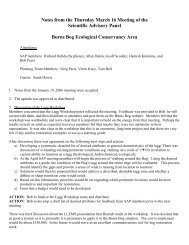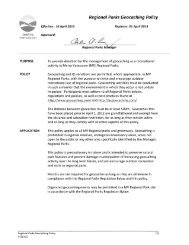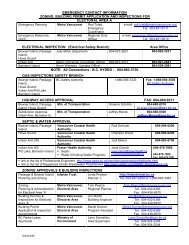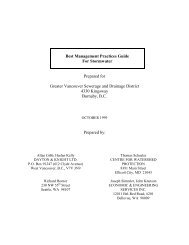Chlorine Monitoring and Dechlorination Techniques Handbook
Chlorine Monitoring and Dechlorination Techniques Handbook
Chlorine Monitoring and Dechlorination Techniques Handbook
Create successful ePaper yourself
Turn your PDF publications into a flip-book with our unique Google optimized e-Paper software.
3.1 Types of Responses<br />
<strong>Chlorine</strong> <strong>Monitoring</strong> <strong>and</strong> Dechlorinating <strong>Techniques</strong> H<strong>and</strong>book<br />
APPROACH TO DECHLORINATION<br />
The methods <strong>and</strong> equipment used to dechlorinate a water release will be dependent on the<br />
type of water release encountered. For ease of discussion, three types of water releases have<br />
been defined, as follows:<br />
Emergency<br />
Planned Short-term<br />
Permanent<br />
During an emergency water release, such as a water main break, the location <strong>and</strong> volume of<br />
the water release are not known prior to its occurrence. Therefore, equipment, chemicals <strong>and</strong><br />
supplies needed for dechlorination must be assembled prior to the event, <strong>and</strong> they must be<br />
ready to deploy in a very short time. Furthermore, as the conditions of the event are generally<br />
not known until a crew arrives at the site, the dechlorination method used must be relatively<br />
easy <strong>and</strong> quick to deploy in a variety of situations.<br />
As an example, the GVWD has emergency dechlorination kits ready to deploy at all times<br />
<strong>and</strong> are kept in their vehicles. Their response to an emergency water release is to place fibre<br />
mesh bags containing granular sodium thiosulphate in the flow path of the released water<br />
(the bags allow water to easily contact the chemical). These bags <strong>and</strong> ancillary equipment<br />
needed to deploy the bags are made up in advance <strong>and</strong> are immediately available for a<br />
response.<br />
Where the location <strong>and</strong> volume of water to be released are known <strong>and</strong> can be controlled, this<br />
is referred to as a planned release. Planned releases include events such as water main<br />
flushing or concrete curing at a construction site. It should be noted that water originating<br />
from a concrete curing operation likely has a high (basic) pH which can also be lethal to fish.<br />
For a planned release, time is not as critical as an emergency event. Time is available for<br />
preparation at the site. In these situations, the GVWD typically uses a solution of sodium<br />
thiosulphate for dechlorination instead of the solid form. This solution is metered into the<br />
flow of the released water. Using a solution of sodium thiosulphate is much more cost<br />
effective than using bags of solid sodium thiosulphate as much less dechlorinating agent is<br />
used in the dechlorination process.<br />
Where chlorinated water will be released on a long term or permanent basis, such as in<br />
cooling water systems, a more permanent approach to dechlorination is required. In these<br />
Page 10

















